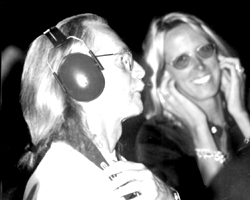| | | |||
 | ||||
 In an earlier column here (for a drag racing journalist, given the transitory aspect of the current media in which continuing columns exist, that’s a really meaningful phrase, even if I’m taking maximum liberty with it here!), I related that I attended my first drag racing event in 1951. Now, some might extrapolate that to mean that I’m one of those sources of seemingly endless facts about our sport of choice. That "some" would be mistaken! I have never been slotted for that type of dynamic RAM; rather, I send those inquiring about the air temperature, dew point, relative humidity, and track surface temperature at a particular match race in, say, Sumerduck, Virginia, on the second weekend of August, 1960-something, down the road, pointed in the general vicinity of the abode of either Mr. Chris Martin or Mr. Bret Kepner. They are the guys who suffer the mind-boggle of stuffing all that arcane numerology into their heads and having to recall and regurgitate it in a matter of microseconds, and still suffer the slings and arrows of outrageous fortune flung back by questioners who fully expect response to the third decimal place in a span of nanoseconds. In an earlier column here (for a drag racing journalist, given the transitory aspect of the current media in which continuing columns exist, that’s a really meaningful phrase, even if I’m taking maximum liberty with it here!), I related that I attended my first drag racing event in 1951. Now, some might extrapolate that to mean that I’m one of those sources of seemingly endless facts about our sport of choice. That "some" would be mistaken! I have never been slotted for that type of dynamic RAM; rather, I send those inquiring about the air temperature, dew point, relative humidity, and track surface temperature at a particular match race in, say, Sumerduck, Virginia, on the second weekend of August, 1960-something, down the road, pointed in the general vicinity of the abode of either Mr. Chris Martin or Mr. Bret Kepner. They are the guys who suffer the mind-boggle of stuffing all that arcane numerology into their heads and having to recall and regurgitate it in a matter of microseconds, and still suffer the slings and arrows of outrageous fortune flung back by questioners who fully expect response to the third decimal place in a span of nanoseconds. Me? I’d rather respond to a query less demanding of immediate response, giving me time to seem lost in deep philosophical considerations while, in truth, really just trying to remember what it was I was supposed to be doing after reaching this particular spot in the time-space continuum at the particular moment. Such as, from a fetching lass considerably younger but with many more body piercings than I, "When was the first drag race held?" Easy!…"When they built the second car! Next question?" "Okay, so, great grandfather of the clan 1320, what’s the biggest difference between going to your first drag race, back when wheels were still square, and now?" Aha! The young questioner had just proved her own ignorance of the past, lacking the knowledge that, exactly at that time, the top classes were allowed to run triangular wheels, as long as all angles were equal. But not to tarry further, I considered the question and was immediately alarmed at all the possible responses. There is the fact that organized drag racing has grown from an entity peopled with perceived outlaws, to a structure in which the principals are fully conversant with the captains of industry. (Don’t go there! They are not all outlaws, or at least it hasn’t yet been proven so in court!) Then, there is the matter of the racing plants themselves: Taj Mahals compare to what was there half a century earlier (Half a century?!! My god, we are historical!!) In fact, there are so many comparisons I could make that it would take a small book to include them all — or maybe a BIG book! But for the nonce, I’ll respond more viscerally … it’s the sound and power, lad and lass; it’s the ungodly concussion resulting from all the horsepower engineered into and released from the racers’ engines that snaps my head around first and most when I go to the races these days. Time was, it was a rite of passage among those reporters and photographers lucky enough to get a chance to stand between two revs-up top fuelers as the flagman … err, ’tree … counted down, to do so, and … without ear protectors! Even as hearing-impaired as some of us have become from the cumulative effects of our years in drag racing, I can’t even imagine doing that today. Hey! that’s 6000 horses time two, shrieking at the top of their lungs, each machine hauling well over a ton of metal and flesh a quarter of a mile in less time than even a super-quick motor drive camera can machine-gun a roll of film through its sprockets. I mean, that’s quicker than a souped-up Chiv-oh-lay (so to speak). Not that the machines of yore weren’t loud in their own right — the noise emanating from drag strips has always been a concern when planning one in a setting in which local housing is nearby. But we used to hear that noise with our ears! Anymore, it begins in the chest cavity and expands … through every pore of your body. Just say it: "Six thousand horsepower!" And at what decibel level … "Megadeth" times a million?! We used to be proud of getting 300 horses out of a flathead — that’s three hundred! So, anyway, as I’m still young enough to be curious, I went looking to find out, in a parallel universe, just how much horsepower 6000 is. First, I found that the Canadian Pacific Railway, in a report relating the updating of its array of locomotives last year, announced that, "…20 new GM units, rated at 6 000 horsepower, will be the most powerful in the CPR fleet." Did’ja ever see the load those babies haul? Log City! Literally! And in Charleston, South Carolina, when the port authority went looking for equipment to shepherd cargo ships as long as 950 feet through Charleston’s Drum Island Reach - Myers Bend turn, they found they would need a tug boat equipped with an engine rated at 6000 hp to do the job. And what’s comparable in length to 950 feet? Even the newest drag racing fan can figure that out. Want another? The most powerful piece in Caterpillar’s earth-moving equipment catalog is rated at, ta-da!.... you got ‘er, Chester! And finally, I came up with a comparison that goes a stretch beyond our implied parameters, but I think you’ll see the appropriateness of the relationship: If we could take the two dragsters we were hypothetically standing between a few paragraphs back, losing our hearing to say nothing of our nitro’d out minds, each powered at our given of 6000 and add an Austin Coil tune-up of some 2000 additional ponies to each (think he couldn’t?? okay, call Jenkins!), giving us a total of 16,000 horses on tap, we’d have enough ponies to power the U.S.S. Nitro (really!), to her full flank speed of 20 knots. Not impressed yet? Well, please read on, McDuff. The ‘Nitro was launched in 1958 as a 512-foot-long, 15,489 ton(!) load capable ammunition ship at Sparrow’s Point, Maryland. I think the ammo ship designation is especially appropriate. (Wonder how many "bullets" and "grenades" she could carry?!). S’matter of fact, the ‘Nitro had her own class in naval history. She, along with her sister ships, the U.S.S. Pyro (cool!) and the U.S.S. Haleakala, comprised the Nitro Class of Ammunition Ships of the U.S. Navy at that time. The ‘Nitro had a complement of 18 officers and 327 enlisted men aboard while she served faithfully from 1958 until 1995. (Seems like overkill on the pit crew numbers, but the chassis builder surer’n hell knew what was goin’ down!) Well, thanks for hanging around for the history and physics lesson. I didn’t intend that at the outset, and I guess I got a bit carried away there, but drawing these comparisons really put things in better prospective for me, and makes me appreciate even more where we’ve come from and where we are in the development of good ol’ drag racing technology over the past five decades. Hope it does same for you.
photo by Jeff Burk
| ||||
|
Copyright 1999-2001, Drag Racing Online and Racing Net Source | ||||
